 |
The mark 7 Ford Transit was launched in August 2006. |
BT's contracts for vehicles tend to favour different manufacturers at varying periods such that both Ford and Vauxhall have supplied vans for the fleet within recent years.
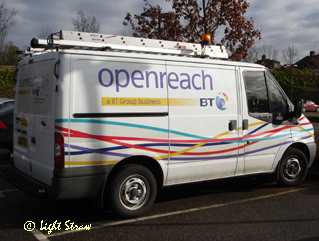 |
The Ford Transit is the commonplace medium sized van for Openreach duties. |
Ford Transit Press Release 2006
BRENTWOOD, Essex - 10 August, 2006 - The appearance on Britain's roads of the new-generation Ford Transit in Openreach livery marks the renewal of a major agreement between Ford and BT that is now in its 20th year.
The contract means that Ford will go on supplying the vans that make up BT's 16,000-strong medium commercial vehicle fleet until at least March 2007.
The previous renewal of this contract, in 2002, was the single biggest fleet deal in the manufacturer's history. Most of the vehicles covered by the latest agreement, which came into effect in January, will be new-generation Transit.
Openreach engineers install and maintain access networks at homes and businesses on behalf of a wide range of telephone and internet service providers. Most of the new Transits in the BT fleet carry the striking Openreach livery, unveiled earlier this year at the launch of Openreach on 11 January.
The contract renewal followed a competitive tendering exercise, with the new Ford Transit selected primarily on the basis of whole-life costs.
"The creation of Openreach and a new fleet demanded the very best Transit model we could find to deliver excellent service to end users up and down the country, on behalf of our customers," said John Youé, BT fleet's procurement manager.
"The existing Transit is a very reliable product that we've come to know very well, and Ford was able to offer us a competitive deal on the new Transit, with the ideal contract for our needs. Our engineers are used to Transits, our workshops know how to maintain them, and they are popular vehicles."
The BT Transits, which are all diesel, have to meet a wide range of operational requirements. The company uses standard short wheelbase panel vans as payphone and customer service engineering vehicles as well as personnel-carriers and stores vehicles. It also buys chassis cabs for fitting with box bodies, to be used as mobile workshops for larger scale tasks, such as network construction. A small number of long wheelbase Transits are also included in the order.
"The vans can carry a number of items of engineering equipment that Openreach engineers use in their day-to-day work, and added features include specialised racking," said Mr Youé.
The improvements to the 2006 Ford Transit range are the most significant for six years, as reflected in its contemporary exterior styling. Key changes include a dashboard-mounted gearshift, disc brakes all-round, a redesigned dash with extra storage space, boosted front-axle capacity and twin batteries.
The range includes six diesel engines, including new 2.2-litre and 2.4-litre Duratorq TDCi units, matched with either five- or six-speed Durashift manual transmissions.
All Transit diesel units feature the latest common-rail technology and meet Euro IV emissions standards. There are 60 basic structures and body styles.
Kevin Griffin, Ford's fleet operations director, welcomed the new BT contract. "After celebrating 40 years of Transit success last year, it's good to enjoy another significant Transit landmark - the launch of the 2006 Transit and continuation of our long-standing relationship with one of the UK's biggest commercial vehicle fleets," he said.
Ford Transit Variants
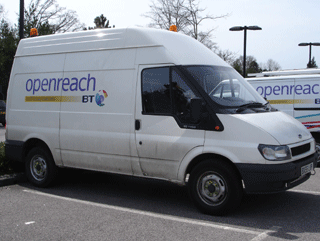 |
Photo: Openreach Ford Transit (high roof) 90 T350 BX55 LUP, type code 607, at a BT training centre © LSA April 2010 |
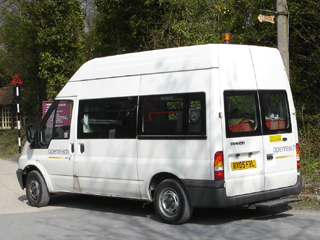 |
Photo: Openreach Ford Transit (high roof) 100 T300 BX05 FBL at Amberley Museum © LSA April 2010 |
 |
Photo: Openreach Ford Transit 85 T300 LF05 YUD at a BT training centre © LSA April 2010 |
Launched in April 2012 the Transit Custom is the most recent derivation of the Ford van in the UK. During 2014 Openreach branded Transit Customs have become part of the BT Fleet.
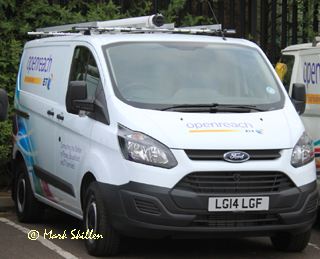 |
Transit Custom. |
| One Tonne Anglian Bodywork | |
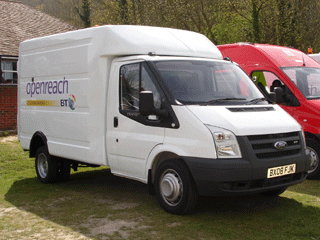 |
The Ford Transit TDCi one-tonne Utility with Anglian bodywork fitted out by Papworth is ideally suited to Openreach duties. |
| Transit with Versalift | |
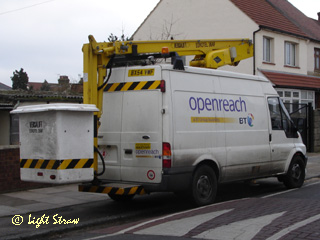 |
An Openreach Ford Transit with Versalift. |
What is the purpose of the yellow tear-shaped pieces of plastic around the wheel nuts of certain vehicles?
 |
Simon Cooper of Surepoint Ltd explains: |
 |
In 1990, engineer Peter Brawley created the loose nut indicator so that wheels can be checked visibly. The idea has been adopted almost universally as the fastest and most accurate method of checking the wheel nuts of public service vehicles." |
All logos and trade marks are the property of their respective owners and are used on the Light Straw site(s) for review only. Students and researchers are recommended to make their own independent enquiries as to the accuracy of the information contained therein.